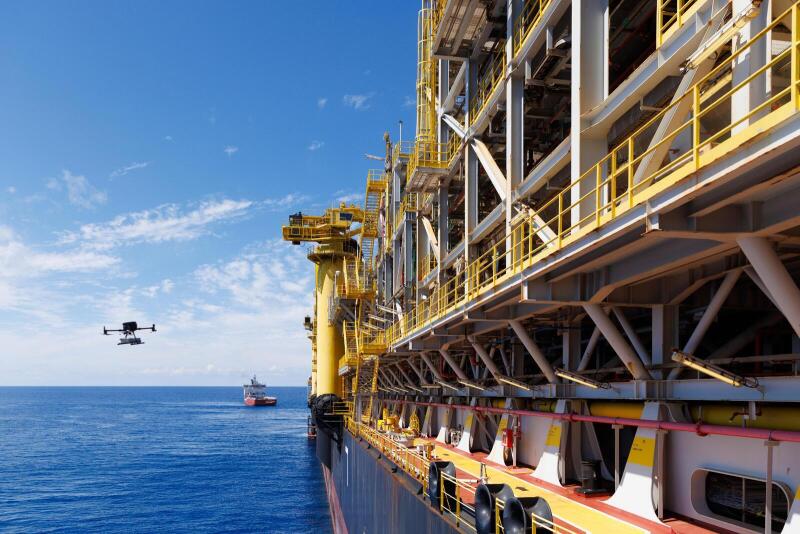TotalEnergies said on 5 December it is sharing “one of the most accurate technologies in the world” for detecting and measuring CO2 and methane emissions.
The French energy giant made the announcement at the climate-focused COP28 in Dubai where it signed agreements to share its technology with national oil companies Petrobras (Brazil), Sonangol (Angola), and SOCAR (Azerbaijan)—all operators of TotalEnergies' nonoperated assets.
The partnerships mark a strategic expansion of TotalEnergies’ AUSEA system (Airborne Ultralight Spectrometer for Environmental Applications) which has already become a central tool in the company’s effort to cut its emissions from 2020 levels in half by next year.
Since last year, TotalEnergies has used the technology to monitor sites that it believes account for 95% of its methane emissions, opting to use other commercial technologies at the remaining locations.
"For the oil and gas industry, cutting methane emissions from operations is a priority as technologies are available. The first step is to measure emissions, asset by asset. By making our AUSEA technology available to our partners, TotalEnergies is taking a concrete step to encourage the whole industry, including national companies, to aim for zero methane emissions," Patrick Pouyanné, CEO of TotalEnergies, said in a statement.
Rapid Measurements
In development since 2017 with a French research institute and a university, the AUSEA system is the subject of a technical paper (SPE 210935) published last year. It illustrates that the effort behind the drone-based technology was driven by a need to quantify emissions rapidly and reliably at an industrial scale.
Among the innovations touted by TotalEnergies is a lightweight sensor called an "open- path laser absorption spectrometer" that is capable of taking a measurement of CO2 and methane levels 24 times per second. This high frequency, effective in various emission concentrations, offers a high degree of precision which is required for monitoring industrial sites, the operator’s authors highlighted. The ability to collect high-resolution data locally is also noted to circumvent the logistical and legal challenges associated with long-range aerial operations.
Additionally, TotalEnergies paid special attention to the challenge posed by wind, which disperses and scatters emissions plumes. The operator has tried to account for this issue by programming its drone to take readings while flying in a horizontal flight pattern as a separate, ground-based LIDAR system takes wind velocity measurements. The authors said this tandem mitigates the need for interpolation, thus delivering increased accuracy.

Trials and Roadmap
The first field trials done between 2019 and 2021 saw the AUSEA platform deployed to a diverse set of industrial sites, including a landfill, biogas plant, and multiple oil and gas facilities located both onshore and offshore.
One notable finding from these early deployments was that actual methane emissions at some facilities were significantly higher than predicted. For instance, an unidentified platform offshore Europe proved to have nearly double the expected emissions, the source of which was later traced to a leaking valve. Another mission identified what was described as “a major fugitive event” at an onshore site in Guinea.
In 2022, TotalEnergies launched a more extensive monitoring campaign using the AUSEA system across four continents and 150 locations. This follow-up campaign revealed that CO2 emissions were largely within expected ranges and that fugitive sources were able to be addressed by site staff.
Additionally, it was discovered that most of the company's flare stacks had a combustion efficiency of 99%, higher than the previously assumed 98%. While the paper does not draw any conclusions from this finding, it mentions the construction of a database to further study flare efficiencies.
TotalEnergies has said that its long-term plan is to scale up the number of AUSEA deployments by making the system autonomous. To this end, the company is working on an unmanned navigation system that will process data and issue reports back to its operators on the ground in real time.
Looking beyond its NOC partners, TotalEnergies plans to use the AUSEA platform in its renewable gas and refining businesses and may market the technology to other companies involved in biogas, combined-cycle turbines, and LNG shipping.
For Further Reading:
SPE 210935 Industrial Facility Top-Down Green House Gas Emissions Quantification Using In-House Gas Analyzer AUSEA Deployed by Drone by Ludovic Donnat and Nicolas Huet, TotalEnergies.


